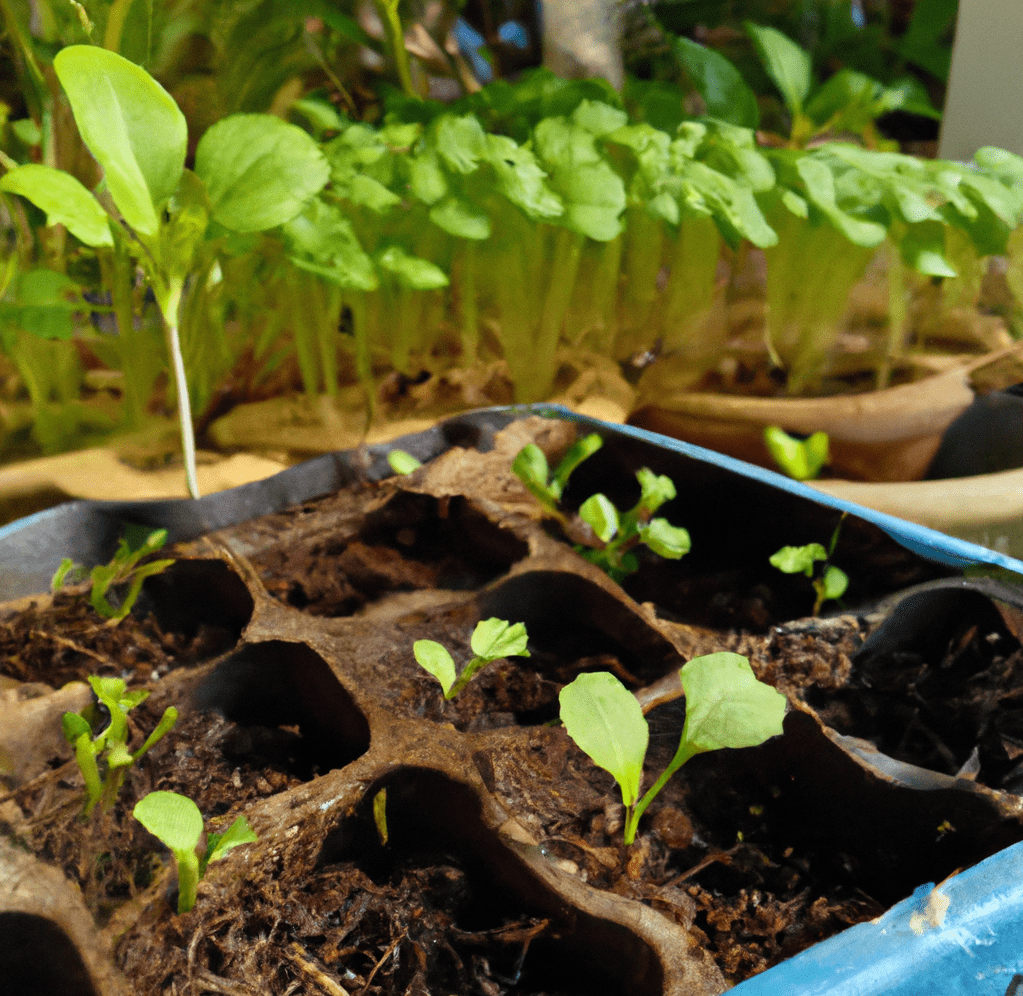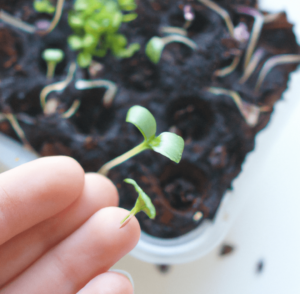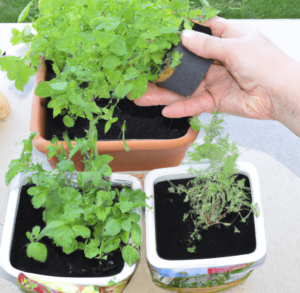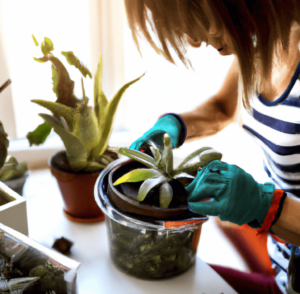Giving organic plants the proper kind of soil, the right amount of nutrients, and regular attention is the secret to developing healthy plants and are the basics of gardening. If you’re wondering about how to grow organic plants, we’ve put together this complete guide!
Planning Your Organic Garden
Before learning how to grow organic plants, planning is key. You can look for gardening guides online or consult an expert but in general:
- Check the pH and nutritional levels of the soil and add compost or other organic matter as needed.
- Pick plants that will flourish in your environment and receive the ideal balance of sun and shade.
- Plan for proper watering and fertilizers while keeping in mind the size and design of your garden.
- Set up a practical gardening schedule and gather the required equipment and supplies.

Choosing the Right Location
Your plants will receive the nutrients, water, and sunlight they need to develop and thrive if you choose the correct spot which is why location is so important in learning how to grow organic plants:
- Type of plants: Think about the kind of plants you want to grow and how much sun and shade they require. Select a place that will give the plants you have in mind the proper quantity of sunlight and wind protection.
- Products: If you want to grow vegetables, pick a spot that receives at least six hours of sunlight every day. For healthy growth and a plentiful yield, vegetable plants require lots of light.
- Garden size: Consider the size of your garden when deciding where to put it, making sure there is enough room for your plants to develop and expand. Take into account how your garden is laid out and position the plants to maximize the space.
- Water: Water is crucial to the success of your garden. If you’re going to build a watering system, pick a place that has access to a water source. Make sure your garden is situated close to a water supply so you can quickly and effectively water your plants.
- Nutrients: Take into account the nutrients your plants will require to develop and prosper. To make sure that your plants receive the proper quantity of nutrients, choose a location that offers the ideal balance of sun, shade, and wind protection.
Identifying the Best Soil Type
Your garden’s soil is essential to the health and growth of your plants as you learn how to grow organic plants. Think about the following factors:
- pH level and nutrients: You may test your soil to find out its pH and nutrient content. You can adjust the soil as necessary by adding compost, peat moss, or other organic matter based on the findings. For plants to develop healthily and productively, the soil has to be properly nourished.
- Plant requirements: Pick plants that will thrive in your soil and climate. Find out the particular requirements of the plants you want to cultivate, such as the preferred soil and the quantity of sunlight, shade, and water required. For instance, Vegetable plants have particular needs for their soil, including good drainage and a pH range of 6.0 to 7.0.
- Water: Water is a crucial component of healthy soil. Make sure your garden is close to a water supply, and if it isn’t, think about setting up a watering system. Consistently water your plants; don’t overwater them as this might cause root rot and other issues.
Determining the ideal sort of soil for your organic garden is crucial whether you’re planting herbs, flowers, or veggies.
Deciding Which Plants to Grow
In order to have a good and fruitful growing season, selecting the right plants for your organic garden is essential before learning how to grow organic plants:
- Nutrients: Find out the particular requirements of the plants you want to cultivate, such as the preferred soil and the quantity of sunlight, shade, and water required.
- Type of plants: Again, choose plants that will thrive in your soil and climate. Consider the type of garden you want to build, such as a herb, flower, or vegetable garden if you’ve just learned how to grow heirloom plants.
- Water: Ensure that your plants have access to enough water. If necessary, select plants that are drought-tolerant based on the local conditions. Planting water-demanding plants in dry locations are not recommended.
Planning and preparation are essential when growing plants organically. Pick the right plants for your soil and climate, and give them the right nutrients and care.
Preparing the Soil
For your organic garden to produce healthy, prolific plants, the soil must be prepared properly. As you learn how to grow organic plants, you can prepare the soil by:
- Evaluate the soil and make any necessary amendments before establishing a garden, whether it’s a vegetable or flower garden.
- To increase the soil’s structure and fertility, do a pH and nutrient content test and add compost, peat moss, or other organic matter.
- To create the optimum environment for your plants to develop in, loosen the soil to a depth of at least 12 inches and add any necessary nutrients.
Amending the Soil With Organic Matter
Now that you know more about how to grow organic plants, you can amend the soil as needed. Growing wholesome, fruitful plants is made simpler by the addition of organic matter to the soil, which can enhance its structure, fertility, and water-holding ability:
- Organic matter can be added to soil in a number of ways, such as by adding compost, peat moss, or well-rotted manure. Select organic material that is suitable for the plants you want to cultivate as well as your soil type.
- Organic matter can improve soil structure, allowing roots to more easily penetrate and obtain water and nutrients, as well as help plants get the proper balance of nutrients.
- Natural processes are used in organic gardening to preserve soil fertility and give plants a healthy environment to develop in. An important part of this strategy is amending the soil with organic materials.
- The need for frequent watering can be decreased by adding organic matter to the soil, which can also aid to enhance its ability to store water. This may be crucial in regions with a water deficit.
Testing the Soil pH
Growing healthy and fruitful plants in your organic garden depends on the pH of the soil. The availability of nutrients for your plants as well as their general health and growth might be impacted by the pH level of your soil:
- You must obtain a soil test kit from a garden store or internet retailer in order to find out the pH of your soil. Simply follow the guidelines to gather a soil sample and determine the pH.
- With a neutral pH of 7.0, soil pH levels can range from acidic to alkaline. Although certain plants require slightly acidic or alkaline soil, most plants thrive in soil with a pH between 6.0 and 7.0. Finding out the pH needs of the particular plants you wish to grow in your organic garden is crucial.
- You might need to amend the soil with organic matter if the pH is out of range, either too high or too low. For instance, lowering the pH of alkaline soil can be accomplished by adding compost, peat moss, or well-rotted manure.
- It’s crucial to routinely test your soil’s pH and modify it as necessary in order to preserve healthy soil and encourage the growth of your plants.
- Evaluating your compost pile on a regular basis to make sure it’s decomposing properly and offering the right balance of nutrients for your plants is a smart idea in addition to testing the pH of your soil.
Creating a Compost Pile
Composting is an important part of organic gardening and a great technique to enrich your soil with the necessary nutrients. You can learn how to grow organic plants well by creating a compost pile:
- Simply collect organic waste like leftover fruit and vegetable peels, leaves, grass clippings, and coffee grounds to start a compost pile. Set up a compost bin or heap these materials in a sunny spot in your garden.
- The decomposition process will move more quickly if the compost pile is routinely mixed to ensure that air and moisture are dispersed evenly.
- In order to introduce helpful bacteria that will aid in the breakdown of the organic materials, you may also add a little amount of soil or compost to the pile.
- The health of your plants can be improved by adding a rich, dark, nutrient-rich soil amendment to your garden beds as the compost pile decomposes and it enhances soil structure and water-holding capacity, facilitating root penetration and nutrient uptake.
Composting is an environmentally responsible approach to decrease waste and conserve resources in addition to adding vital nutrients to your soil. Composting organic waste in your own backyard helps to establish a closed-loop system that is advantageous to your plants and the environment rather than disposing of it in a landfill.

Planting and Care
The last stage in learning how to grow organic plants is actual planting and care.
Choosing the Right Seeds or Plants
Making sure that the seeds or plants you choose are suited to the soil and climate in your area can assist to ensure that they grow and prosper there:
- The amount of water a seed or plant needs is one of the most crucial considerations. While some plants can grow and thrive with a lot of water, others are more drought-tolerant and can do so. You can give your plants the ideal amount of water for growth if you are aware of their water requirements.
- Seed germination is a different aspect to take into account while selecting seeds or plants. This is how seeds germinate and develop into new plants. Some seeds germinate quickly, but others take longer. To guarantee the best results in your organic garden, it’s critical to pick seeds with a high germination rate.
- It’s crucial to think about your plants’ dietary requirements. Choosing seeds or plants that are compatible with the number of nutrients in your soil is crucial because certain plants demand more nutrients than others. Your soil’s nutrient level can be increased by adding compost or other organic materials, which will also promote your plants’ growth and development.
Planting at the Correct Time of Year
Learning how to grow organic plants is choosing the right time to do so. Your plants will receive the proper quantity of water, light, and nutrients to grow and thrive if you plant them at the appropriate time of year.
The majority of vegetables and other plants should be planted in the spring or early summer when the soil is warm and there is enough sunshine for photosynthesis.
Research the particular requirements of each plant you intend to cultivate because some, like garlic and onions, do best when planted in the fall. The risk of disease and insect problems can be decreased and your plants will produce healthy crops if you plant at the appropriate time of year.
Watering and Fertilizing Correctly
Two crucial components of organic gardening-fertilizing and watering-can have a significant impact on the well-being and development of your plants. As you’re learning how to grow organic plants, watering, and fertilizing them correctly, keep the following tips in mind:
- It’s crucial to water plants so that the soil is evenly moist but not soggy, as this might cause root rot.
- According to the weather and the requirements of your plants, a decent rule of thumb is to deeply water once or twice a week.
- Using compost or other organic materials as fertilizer can provide your plants with the nutrients they require.
- Composting is a terrific way to improve the fertility of your soil without using artificial fertilizers. It may be prepared from a number of organic items, such as food waste, leaves, grass clippings, and more.
- To boost your plants’ nutrients, you can also apply alternative organic fertilizers like bone meal or fish emulsion.
- When using any fertilizer, always follow the directions on the box and be mindful not to overfertilize as this can result in issues like leaching and soil damage.
Controlling Pests and Diseases Organically
Organic gardeners strive to establish a healthy ecosystem in their gardens that will naturally aid in the control of pests and illnesses rather than relying on chemical pesticides. Learning how to grow organic plants is protecting them organically as well. We recommend:
- Planting a variety of crops, rotating crops annually, and promoting beneficial insects and other predators in the garden are some strategies for doing this.
- Keep an eye out for pest and disease indicators and to take action as soon as you see anything out of the ordinary.
- You might try utilizing insecticidal soap or another natural spray to get rid of the bugs if you notice signs of an insect infestation. If you find a disease infecting your plants, you should remove the sick plants as soon as possible and work to keep your garden clean to stop the disease from spreading.
Harvesting and Preservation
An essential part of learning how to grow organic plants is harvesting and preserving them too. Knowing when to harvest your plants for maximum flavor and nutrient content is crucial. You should also know how to store and preserve your food for utmost freshness.
When it comes to harvesting, time is everything, whether you are producing fruits, vegetables, or herbs. For instance, herbs like basil should be plucked just before they begin to flower, whereas crops like tomatoes and cucumbers should be harvested when they are fully ripe and ready to eat.
Your organic produce’s shelf life can be increased and its nutrients preserved by using appropriate storage and preservation techniques like freezing, canning, or refrigeration.
Bottom Line: How to Grow Organic Plants
Learning how to grow organic plants is great for you and the environment. You can establish a thriving organic garden by carefully choosing the right soil, adding organic nutrients, and giving it the necessary care and attention.
The organic gardening community is full of tools and assistance to guide you whether you are an experienced gardener or a novice. So let’s choose to produce organic plants in order to protect the environment and our health!
FAQs on How to Grow Organic Plants
What is organic gardening, exactly?
Growing plants organically means avoiding the use of pesticides and other synthetic chemicals. Giving plants the right soil, nourishment, and attention is necessary for them to flourish healthily.
What essential elements of organic gardening?
Important elements of organic gardening include regular watering, weeding, keeping an eye out for pests and diseases, and adding compost or other organic waste to enhance soil fertility.
What are the advantages of cultivating organic plants?
Growing organic plants has several advantages, including improved consumer flavor and health, a healthier environment, and support for regional farmers.
What goes into designing an organic garden?
Choosing the right plants for the environment, preparing for correct watering and fertilizing, creating a timetable for gardening, and obtaining the essential tools and supplies are all part of designing an organic garden.
What factors should I take into account while deciding where to put my garden?
Take into account aspects like sunlight, wind protection, accessibility to water and nutrients, as well as the size and layout of the garden, when deciding where to put your garden.
What factors should I take into account when choosing which plants to grow?
Take into account your climate, the type of soil you have, the size of the plants, and their nutrient and water needs when choosing which plants to cultivate.
What factors go into choosing the optimum soil type?
In order to choose the optimal soil type, it is necessary to test the pH and nutrient content of the soil and to add compost or other organic matter to the soil as the soil requires it.
What part do nutrients play in organic gardening?
In an organic garden, nutrients are crucial for the growth and well-being of plants. Make sure the soil is supplying enough nutrients and take into account the nutrient requirements of the plants you intend to grow.
Why is composting necessary in organic gardening, and what is it?
The process of composting involves turning organic waste into a nutrient-rich soil supplement. It is a crucial component of organic gardening since it enriches the soil with essential nutrients, enhancing plant health and productivity.
What supplies are available to start a compost pile?
A compost pile can be started using organic waste, such as fruit and vegetable peels, leaves, grass clippings, and coffee grounds.
A compost pile should be stirred up how frequently?
A compost pile needs to be regularly stirred to distribute air and moisture evenly, which speeds up the decomposition process.
What environmental advantages can compost offer?
A closed-loop system is created by composting organic waste in your own backyard, which not only conserves resources and minimizes waste but also enriches the soil with necessary nutrients.
What time of year is ideal for planting in an organic garden?
The ideal season for planting in an organic garden depends on the particular needs of each plant, but the majority of vegetables and other plants should be planted in the spring or early summer. However, you could learn how to grow plants in extreme climates if necessary.
How frequently should plants in an organic garden be watered?
Depending on the weather and the needs of your plants, it’s a good idea to deeply water plants once or twice a week.
Which fertilizer strategy works best for plants in an organic garden?
The ideal method for organic gardening is to use compost or other organic materials as fertilizer. To provide plants with a boost in nutrients, alternative organic fertilizers like bone meal or fish emulsion can also be employed.







